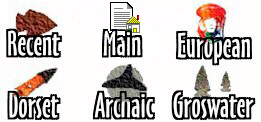![[Header]](history.jpg)
![[Header]](history.jpg)
Brief History
Paleoeskimos (Prehistoric Eskimos) are not the direct ancestors of the modern-day Inuit in Labrador. They were the first people to inhabit the Arctic region of Canada approximately 4,500 years ago. It is believed that a warming climate trend between 5000-4000 B.P. (Before Present) resulted in lighter landfast ice conditions in the Bering Sea, and caused a decline in the Ringed Seal population upon which the Paleoeskimos depended. This probably put pressure on the Paleoeskimos to move to more favorable hunting areas, and undertake a 5,500 km. eastward journey to the Eastern Arctic around 4500 B.P. The trek took 500 years to complete over successive generations. They reached the Eastern Arctic 4000 B.P. and were in Labrador by 3800 B.P.
The Inuit are the descendants of the Thule. The Thule represents the second west to east migration that took place about 1,000 years ago, during another warming trend in the climate. Thule were whale hunters who made a more rapid migration across the Arctic, reaching Labrador circa 500 years ago. They never came to the island of Newfoundland. After arriving in Labrador they adapted their technology and economy to the local conditions and became seal hunters.
Background at Port au Choix
The island of Newfoundland was the most southerly point inhabited by the Paleoeskimos; the earliest site found at Cow Head dates to 3100 B.P. Starting around 2800 B.P. they began to expand southward on the island where sites have been found throughout, except on the Avalon Peninsula. These Paleoeskimos are called Groswater Paleoeskimos after Groswater Bay in Labrador, where they were first identified. They occupied the Port au Choix area from 2800-1900 B.P.
Several Groswater Paleoeskimo sites have been found at Port au Choix. They are the Cornick Site, Northcott-Rumbolt Site, and the two larger and better-known sites of Phillip's Garden East and West. The Groswater were very mobile, lived in small groups and moved from season to season in a planned strategy of resource acquisition that included both marine and terrestrial components. Their sites, located along the coast, were used during the spring when they came to the area to hunt seals. The occupations at Phillip's Garden appear to be task-specific.This is because of the high proportion of seal bones and a high proportion of hunting and processing tools (endblades and microblades).
Their shelters were temporary seasonal hunting camps, occupied during warm weather. The interiors of the structures had no fireplaces, which were usually found just outside the structure. Inside the tents were sleeping platforms made from large rocks that raised the occupants off the damp ground. It would have been covered with boughs and animal skins. Since they only spent short periods of time here, they left little debris behind. They were very mobile and did not use large soapstone pots or lamps because these would be too heavy to carry from place to place. They heated rocks in an open fire to radiate heat, and placed them inside a birchbark or skin container to boil water. Evidence of fire-cracked rocks from hearths (fireplaces) are common at their sites.
![]()
Follow These Links
History and Background
![]()
